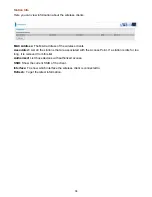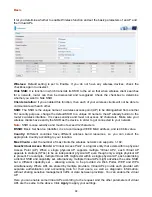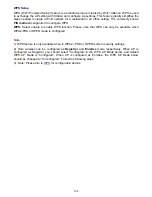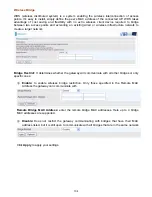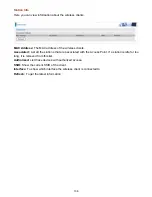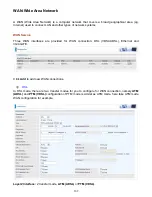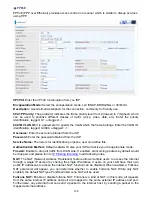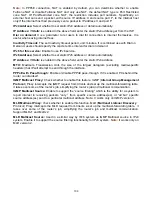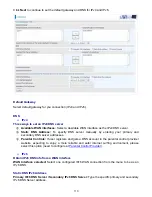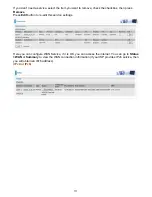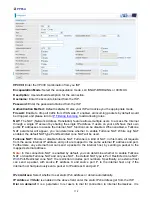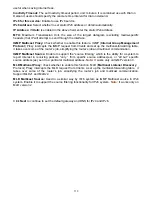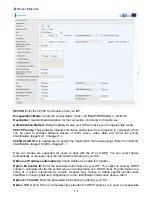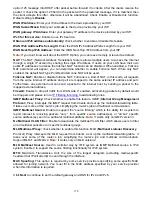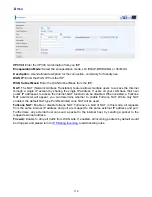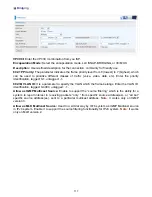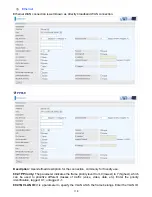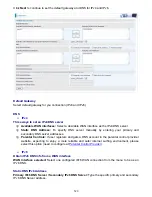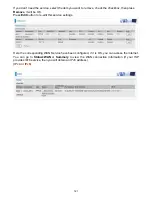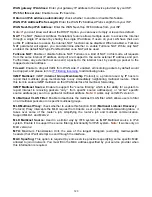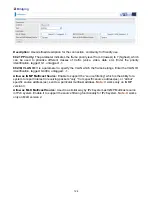
109
Note:
In PPPoE connection, NAT is enabled by default, you can determine whether to enable
Fullcone NAT or disable Fullcone NAT and only use NAT, the default NAT type is Port Restricted
cone NAT. Of Port-Restricted cone NAT, the restriction includes port numbers. Specifically, an
external host can send a packet, with source IP address X and source port P, to the internal host
only if the internal host had previously sent a packet to IP address X and port P
IPv4 Address:
Select whether to set static IPv4 address or obtain automatically.
IP Address:
If
Static
is enabled in the above field, enter the static IPv4 address get from the ISP.
Dial on demand:
It is a parameter to let users to dial for connection to internet themselves. It is
useful when saving internet fees.
Inactivity Timeout:
The set Inactivity timeout period, unit: minutes. It is combined use with Dial on
Demand, users should specify the concrete time interval for dial on demand.
IPv6 for this service:
Enable to use IPv6 service.
IPv6 Address:
Select whether to set static IPv6 address or obtain automatically.
IP Address:
If
Static
is enabled in the above field, enter the static IPv4 address.
MTU:
Maximum Transmission Unit, the size of the largest datagram (excluding media-specific
headers) that IP will attempt to send through the interface.
PPPoE with Pass-through:
Enable or disable PPPoE pass-through. If it is enabled, PCs behind the
router can dial itself.
IGMP Multicast Proxy:
Check whether to enable this feature. IGMP (
Internet Group Management
Protocol
) Proxy intercepts the IGMP request from Clients and set up the multicast-forwarding table,
it takes over some of the router’s job, simplifying the router’s job and multicast communication.
IGMP Multicast Source:
Enable to support the “source filtering” which is the ability for a system to
report interest in receiving packets “only ” from specific source address(es), or “all but” specific
source address(es), sent to a particular multicast address.
Note:
It works only on IGMP version 3.
MLD Multicast Proxy:
check whether to enable this function. MLD (
Multicast Listener Discovery
Protocol) Proxy intercepts the MLD request from Clients a set up the multicast-forwarding table. it
takes over some of the router’s job, simplifying the router’s job and multicast communication.
Support MLDv1 and MLDv2.
MLD Multicast Source:
Used in a similar way by IPv6 system as IGMP Multicast source in IPv4
system. Enable it to support the source filtering functionality for IPv6 system.
Note:
It works only on
MLD version 2.
Summary of Contents for BiPAC 6900AX(L)-2400
Page 20: ...15 3G LTE Router mode ...
Page 66: ...61 7 Success ...
Page 94: ...89 Configure AP as Enrollee Add Registrar with PIN Method 1 Set AP to Unconfigured Mode ...
Page 144: ...139 Accessing mechanism of Storage In your computer Click Start Run enter 192 168 1 254 ...
Page 146: ...141 Access the folder public ...
Page 149: ...144 Step 2 Click Add a Printer Step 3 Click Add a network wireless or Bluetooth printer ...
Page 160: ...155 Rule inactive ...
Page 196: ...191 ...
Page 199: ...194 ...
Page 208: ...203 4 Input Internet address and Destination name for this connection and press Next ...
Page 209: ...204 5 Input the account user name and password and press Create ...
Page 210: ...205 6 Connect to the server ...
Page 212: ...207 ...
Page 223: ...218 4 Input Internet address and Destination name for this connection and press Next ...
Page 224: ...219 5 Input the account user name and password and press Create ...
Page 241: ...236 2 ipoe_eth0 with DDNS www hometest1 com using username password test test ...
Page 253: ...248 Click Apply to confirm your settings ...
Page 261: ...256 Mobile Network User can press Scan to discover available 3G LTE mobile network ...
Page 267: ...262 Example Ping www google com ...
Page 268: ...263 Example trace www google com ...


